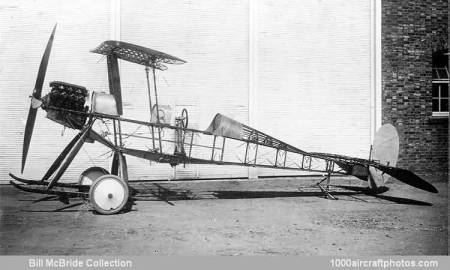02/28/2010. Remarks by Kees Kort: "A casual view at this rather unique picture of an unfinished aircraft would identify it as one of the early versions of the Royal Aircraft Factory B.E.2, however, it isn't.
A closer look reveals two petrol tanks, the first can be seen right in front of the first (observer) position, the second is in front of the second (pilot's) position. The struts supporting the top wing are angled, whereas these struts have a 90° angle to the fuselage on the B.E.2. The landing gear features anti nose-over skids, which are fixed to the fuselage with two struts, and the wheels are fixed on the skids. This differs significantly from the early versions of the B.E.2, which had a strut and a V-strut (in fact three struts)
This indicated the pictured framework is of the R.E.1 (Reconnaissance Experimental 1), designed by H.P. Folland, that appeared in July 1913. Only two examples were built (s/n 607 and 608), powered by a 70 hp Renault eight-cylinder V-engine. One machine did operational service in France in August 1914, but was struck off charge. So the R.E.1 did not make a large dent in aviation history, but it was the first of the R.E. series of Royal Aircraft Factory machines, culminating in the R.E.8."
